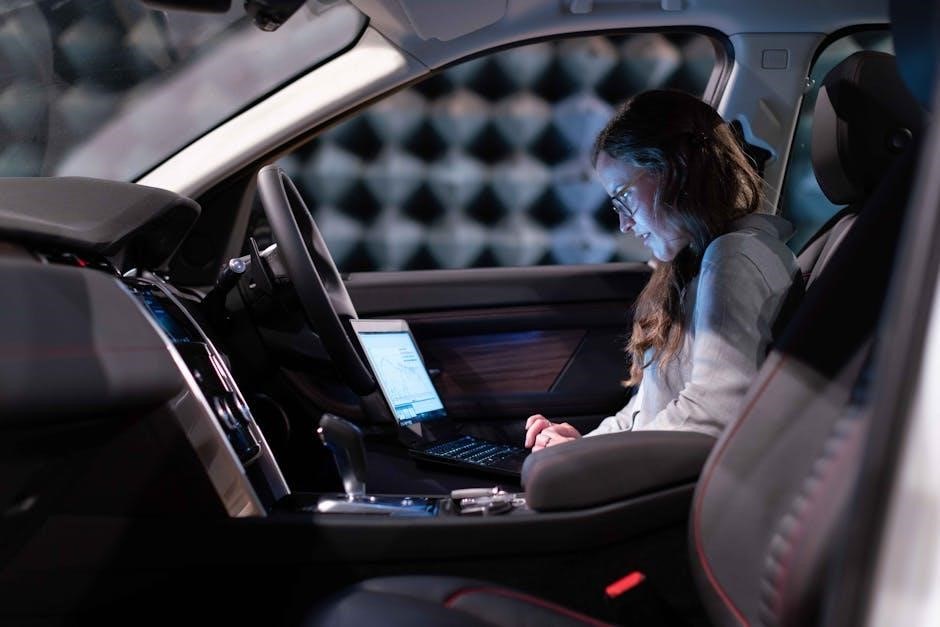This manual provides comprehensive guidance for JVC car audio systems, covering installation, operation, and troubleshooting. It ensures optimal performance and safe enjoyment of advanced features.
Overview of JVC Car Audio Systems
JVC car audio systems are renowned for their high-quality sound, advanced features, and user-friendly designs. These systems cater to a wide range of vehicles, offering compatibility with various models and electrical setups. Many JVC car stereos support Bluetooth connectivity, Apple CarPlay, and customizable audio settings, enhancing the driving experience. They often include intuitive controls, vibrant displays, and seamless integration with smartphones. Designed to operate on 12V DC, negative ground systems, these units ensure optimal performance. JVC systems are also equipped with features like Siri activation, DAB tuners, and firmware updates for improved functionality. Whether it’s streaming music or navigating menus, JVC car audio systems deliver a blend of innovation and reliability, making them a popular choice for drivers seeking premium in-car entertainment.
Importance of Reading the Manual
Reading the JVC car audio manual is essential for understanding system capabilities, ensuring proper installation, and troubleshooting common issues. It provides detailed instructions for setting up advanced features like Bluetooth connectivity and Apple CarPlay. The manual also outlines safety precautions, such as avoiding high volumes while driving and ensuring correct electrical system compatibility. By following the guidelines, users can prevent damage from voltage spikes and ensure optimal performance. Additionally, the manual offers insights into customizing audio settings and updating firmware, enhancing the overall driving experience. Whether you’re a novice or experienced user, the manual serves as a vital resource for maximizing your JVC car audio system’s potential safely and effectively.
Where to Find JVC Car Audio Manuals
JVC car audio manuals can be easily accessed online through various platforms. The official JVC website (www.jvc.net/cs/car/) provides detailed manuals in PDF format, searchable by model number. Additionally, websites like www.servicemanuals.net offer JVC service manuals for download. Platforms like Scribd and ManualsLib also host a wide range of JVC car audio manuals. For specific models, such as the JVC KD-G801 or KD-G409, manuals are available for free download as PDF or text files. Users can also contact JVC customer support for assistance in locating the correct manual for their device. Ensure to enter the model number accurately to find the most relevant guide for your JVC car audio system.

Pre-Installation Setup
Pre-installation setup involves planning the electrical connection, checking vehicle compatibility, and organizing tools for a smooth JVC car audio installation process.
Understanding the Vehicle’s Electrical System
Understanding your vehicle’s electrical system is crucial for a safe and successful JVC car audio installation. It involves identifying the battery, alternator, and wiring harness. Knowing the power sources and grounding points helps prevent electrical damage. Familiarize yourself with the fuse box and circuit breakers to avoid overloading. Always check the voltage and current ratings to ensure compatibility with the audio system. Consulting your vehicle’s manual or a wiring diagram can provide detailed insights. Properly testing the system with a multimeter ensures accuracy. This step is vital to avoid short circuits or electrical fires. Remember to disconnect the battery before starting any work to ensure safety.
Checking Compatibility with Your Vehicle
Before installing your JVC car audio system, ensure it is compatible with your vehicle. Check the dashboard size to confirm the unit fits. Verify the power requirements, such as voltage and current ratings, to match your vehicle’s electrical system. Consult your vehicle’s manual or manufacturer’s website for specific compatibility details. Cross-reference the JVC model with your car’s make, model, and year. Some vehicles may require additional adapters for features like steering wheel controls or Bluetooth integration. Ensure the audio system supports your vehicle’s speaker configuration. If unsure, consult a professional installer or contact JVC support for assistance. Proper compatibility ensures seamless performance and avoids potential installation issues.
Gathering Necessary Tools and Materials
To ensure a smooth installation, gather the required tools and materials beforehand. Essential tools include screwdrivers (Phillips and flathead), pliers, wire cutters, and a soldering iron. You may also need a multimeter for testing electrical connections. For wiring, prepare crimp connectors, wire strippers, and electrical tape. If your vehicle requires specific adapters, ensure you have them ready. Mounting hardware like screws, brackets, and clips should be included with the JVC unit. Additionally, have a wiring diagram for your vehicle on hand. Optional items like a backup camera or steering wheel control adapter may be needed, depending on your setup. Always verify the compatibility of any additional components with your JVC system before installation.

Installation Guide
This section provides a comprehensive guide to installing your JVC car audio system. It covers preparation, safety precautions, and compliance with vehicle-specific requirements for a seamless setup.
Step-by-Step Installation Process
- Disconnect the vehicle’s battery to prevent electrical shocks or damage.
- Remove the factory radio trim and mounting brackets using appropriate tools.
- Connect the JVC unit’s wiring harness to the vehicle’s wiring system, matching colors and functions.
- Mount the new audio unit securely in the dashboard, ensuring proper alignment.
- Reconnect the battery and test the system to ensure all functions work correctly.
- Reassemble the dashboard and trim pieces, tightening all screws firmly.
Follow these steps carefully to ensure a safe and successful installation of your JVC car audio system.
Wiring Diagrams and Connections
Understanding the wiring diagrams is crucial for a successful installation. Locate the wiring harness in your JVC car audio manual, which illustrates the connections for power, ground, and speaker wires. Each wire is color-coded to ensure proper connections.
- The yellow wire is typically for constant power, while the red wire is for ignition-switched power.
- The black wire is ground, which must be connected to a metal part of the vehicle.
- Speaker wires are color-coded to match the vehicle’s speaker system.
Connect the wires carefully, matching colors and functions to avoid short circuits. Use a multimeter to verify connections before powering up the system. Proper wiring ensures safe and optimal performance of your JVC car audio system.
Mounting the Audio Unit Securely
Mounting the JVC car audio unit securely ensures stability and prevents damage during driving. Use the provided mounting kit to fit the unit into the dashboard. Align the unit with the dash opening and gently push it in until it clicks. Tighten the screws firmly to secure it in place. Ensure the unit is level and does not obstruct the driver’s view. If additional support is needed, install brackets or adapters provided with the kit. Once mounted, test the unit by gently tugging on it to ensure it is firmly secured. Proper mounting prevents vibration and ensures optimal performance. Follow the manual’s guidelines for specific mounting instructions tailored to your vehicle.

Operating the JVC Car Audio System
Operating the JVC car audio system involves turning it on, adjusting volume, selecting sources like radio or USB, and using the EQ for sound customization. It’s designed for ease of use.
Basic Controls and Functions
The JVC car audio system features intuitive controls for essential operations. The power button turns the unit on/off, while the volume knob adjusts sound levels. The source button allows switching between radio, CD, USB, and auxiliary inputs. Playback controls include play/pause, track skip, and repeat functions. The menu button accesses settings for customization. EQ settings adjust bass, treble, and balance for optimal sound. Illuminated buttons enhance visibility at night. Additional functions may include mute and phone call management. These controls ensure easy operation while driving, providing a seamless listening experience. Familiarizing yourself with these basics ensures safe and enjoyable use of your JVC car audio system.
Navigating the Menu System
Navigating the JVC car audio menu system is straightforward, allowing easy access to various settings and features. The menu button brings up the main options, while the back button returns to the previous screen. Use the up and down arrows to scroll through menu items and the enter button to select options. Key categories include Audio, System, and Bluetooth. Customize settings like EQ presets, display brightness, and language preferences. Sub-menus offer detailed adjustments, such as audio balancing and crossover settings. The menu system is intuitive, ensuring quick adjustments while driving. Familiarize yourself with the structure to optimize your listening experience without distractions.
Setting Up the Clock and Time

Setting up the clock and time on your JVC car audio system ensures accurate time display and synchronization with other features. Access the clock settings through the Menu button, then navigate to the System or Settings option. Use the up and down arrows to select Clock or Time. Enter the correct time manually or enable Auto Sync to synchronize with your vehicle’s GPS or phone via Bluetooth. Adjust the Time Zone and choose between 12-hour or 24-hour format. Once set, press Enter to save. Ensure the clock is accurate for features like alarms or scheduled functions. This setup enhances your overall experience and keeps you connected to real-time information while driving.

Advanced Features
Explore advanced features like Bluetooth for hands-free calls, Apple CarPlay for seamless iOS integration, and customizable EQ settings for personalized sound. These enhancements elevate your driving experience.
Bluetooth Connectivity and Pairing
Bluetooth connectivity allows wireless streaming of music and hands-free calls; To pair your device, ensure Bluetooth is enabled on your phone and the JVC unit. Select the JVC system from your device’s Bluetooth menu. Once connected, you can stream audio and manage calls directly through the car stereo. For troubleshooting, restart both devices or reset the JVC unit. Ensure your phone’s Bluetooth is updated for compatibility. Always pair devices in a safe environment, avoiding distractions while driving. Refer to the manual for specific pairing codes or additional settings. This feature enhances your driving experience by integrating your phone seamlessly with the car audio system.

Using Apple CarPlay and Siri Activation
To use Apple CarPlay, connect your iPhone to the JVC unit via USB. Ensure CarPlay is enabled in your iPhone’s settings. Once connected, CarPlay will display compatible apps like Maps, Music, and Messages on the JVC screen. For Siri activation, press and hold the voice command button on your steering wheel or the unit’s interface. Siri will respond, allowing voice commands to control navigation, playlists, and more. This integration enhances safety by minimizing manual operation. Ensure your iPhone and JVC system are updated for compatibility. Use a genuine Apple cable for reliable connectivity. This feature simplifies your driving experience by integrating essential iPhone functions seamlessly with your car audio system.

Customizing Audio Settings and EQ
Customizing your JVC car audio system allows you to tailor the sound to your preferences. Access the audio settings menu to adjust options like bass, treble, and balance. Use the equalizer (EQ) to fine-tune frequency levels for a more immersive listening experience. Preset EQ modes, such as “Rock” or “Jazz,” can enhance specific music genres. For a personalized touch, create a custom EQ setting by manually adjusting low, mid, and high frequencies. Ensure the subwoofer and crossover settings are optimized for your speaker configuration. Experiment with different configurations to achieve the perfect sound balance. Refer to the manual for guidance on advanced settings and troubleshooting any audio imbalances. Proper customization ensures optimal sound quality and enhances your overall listening enjoyment.

Troubleshooting Common Issues
Identify symptoms like no power, distorted sound, or connectivity problems. Check connections, fuses, and wiring. Reset the system or update firmware if needed. Consult the manual for specific solutions to ensure proper functionality and resolve issues efficiently.
Resolving Power and Connectivity Problems
If your JVC car audio system isn’t turning on, check the power source and ensure all connections are secure. Verify the ignition switch is in the correct position and the battery is charged. Inspect the fuse box for blown fuses or tripped circuit breakers. For connectivity issues, restart the system or reset it by disconnecting the battery for 10 seconds. Ensure Bluetooth devices are paired correctly and within range. Check the RCA cables for proper connections and damaged wires. If issues persist, refer to the manual for troubleshooting guides or contact JVC support. Regularly updating firmware can also resolve connectivity problems. Always follow safety precautions when working with electrical systems.
Addressing Sound Quality Concerns
If you experience poor sound quality, such as distortion or low volume, check the speaker connections for looseness or damage. Ensure all wires are securely connected to the correct terminals. Adjust the equalizer settings to optimize the audio output for your vehicle’s acoustics. Verify that the volume is set appropriately and that no external devices are interfering with the signal. Clean dust or debris from the speakers and CDs to prevent degradation. If issues persist, test the system with a different audio source to isolate the problem. For severe cases, consult the manual or contact JVC support for further assistance. Proper setup and maintenance can significantly enhance sound clarity and overall performance.
Updating Firmware for Optimal Performance
Regularly updating the firmware of your JVC car audio system is essential for ensuring optimal performance and accessing the latest features. To update the firmware, visit the official JVC website and download the newest version compatible with your model. Transfer the firmware file to a USB drive and insert it into the audio unit. Navigate to the system update menu, following the on-screen instructions to complete the process. Ensure the vehicle’s ignition is turned on during the update to prevent power interruptions. Once the update is successful, test the system to confirm all features are functioning properly. Keeping the firmware up to date ensures improved functionality, enhanced compatibility, and a better overall listening experience. Always refer to the manual for specific update instructions for your model.

Safety and Maintenance
Handle the JVC car audio unit with care to avoid damage. Regularly clean the display and controls using a soft cloth. Protect the system from extreme temperatures and moisture. Disconnect the battery before performing any electrical work to prevent shocks or damage. Always follow the manual’s guidelines for maintenance to ensure longevity and optimal performance. Proper care will enhance your listening experience and maintain the system’s functionality over time.
Driving Safely with the Audio System
Always prioritize safe driving while using your JVC car audio system. Avoid adjusting settings or viewing the screen while driving, as this can cause distractions. Ensure the audio volume is at a reasonable level to maintain awareness of your surroundings. Use hands-free features for phone calls to keep your focus on the road. Install the unit securely to prevent it from obstructing your view or becoming a hazard. Regularly check that all connections are stable to avoid sudden malfunctions. Keep the system updated with the latest firmware for reliable performance. By following these guidelines, you can enjoy your JVC car audio while driving safely and responsibly.
Cleaning and Maintaining the Unit
To keep your JVC car audio system in optimal condition, regular cleaning and maintenance are essential. Use a soft, dry cloth to wipe down the exterior and interior of the unit, paying attention to buttons and knobs. For stubborn stains or smudges, lightly dampen the cloth with water, but avoid harsh chemicals or abrasive cleaners. Never spray liquids directly onto the unit to prevent damage. Clean the display screen gently with a microfiber cloth to maintain clarity. Avoid exposing the system to extreme temperatures or moisture, as this can degrade performance. Dust buildup can be prevented by occasionally using compressed air, but ensure the can is held upright to avoid liquid contact. Regular maintenance ensures longevity and preserves sound quality.
Avoiding Damage from Voltage Spikes
To protect your JVC car audio system from voltage spikes, ensure proper installation by grounding the unit correctly and using high-quality wiring. Install a voltage stabilizer or surge protector to regulate power fluctuations. Avoid sudden power surges by turning off the audio system before starting or stopping the engine. Secure all connections to prevent loose wires, which can exacerbate damage. Consider adding a capacitor to filter voltage spikes, as recommended in the manual. Regularly inspect the system for wear and tear, and replace damaged components promptly. By taking these precautions, you can safeguard your JVC car audio from voltage-related damage, ensuring optimal performance and longevity. Always follow the manufacturer’s guidelines for installation and maintenance.
Thank you for following the JVC car audio manual. Proper installation and maintenance ensure optimal performance. Enjoy your enhanced driving experience with crystal-clear sound and advanced features safely.
Final Tips for Enjoying Your JVC Car Audio
To fully enjoy your JVC car audio system, explore all its features and settings to tailor your listening experience. Regularly update your firmware to access the latest improvements and security patches. Adjust the EQ settings to match your music preferences for optimal sound quality. Keep the system clean and avoid exposing it to extreme temperatures or moisture. For a safe driving experience, minimize distractions while adjusting settings. Experiment with connectivity options like Bluetooth and Apple CarPlay to enhance convenience. By following these tips, you can maximize your enjoyment and extend the lifespan of your JVC car audio system. Happy listening!


